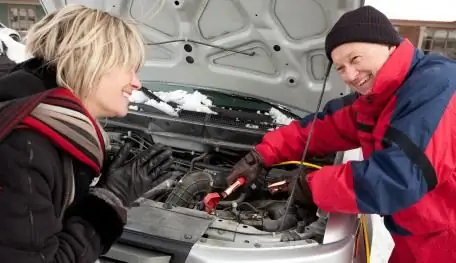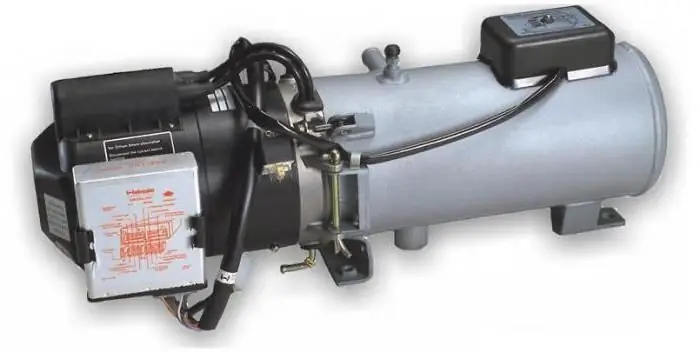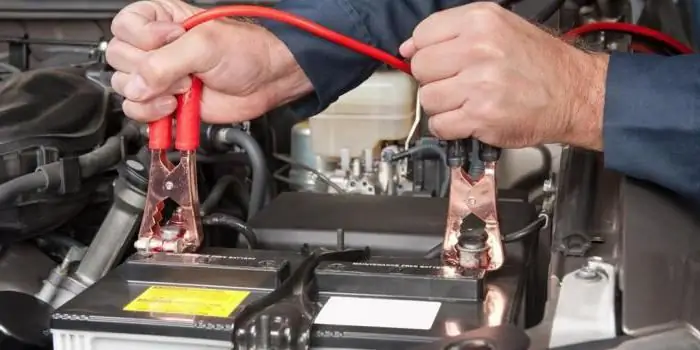2025 Author: Erin Ralphs | [email protected]. Last modified: 2025-01-22 21:14:14
Sooner or later, every car owner is faced with the problem of difficult engine start. And this happens both on gasoline and diesel engines. The latter especially often refuse to start in winter. And all because of the properties of diesel fuel. Indeed, unlike gasoline, there are no spark plugs that would set fire to the mixture. The fuel is ignited by compression force. Plus, diesel thickens at low temperatures. But let's not get ahead of ourselves. So, let's look at why a diesel engine does not start well in the morning. For the main causes and solutions, see our today's article.
Starter and battery
Most starting problems are caused by wear on these two parts. After all, it is on them that the start of the engine "cold" and "hot" depends. If your diesel engine does not start "cold",The reason may be in a discharged battery. The latter, like diesel fuel, is also afraid of low temperatures. It can lose up to 20 percent of its capacity overnight. This is already a critical indicator. As a result, even the new Renault Duster will be impossible to start. What is the solution to the problem? There is only one way out - charging the "planted" battery. This can be done in several ways. The fastest option is to "light up".

With the help of "crocodiles" you connect to the battery terminals of a working car and start the engine. However, the method is quite dangerous, especially for the battery itself.
The second, safer way is to use so-called boosters. Recently, they have become very popular among motorists. The booster is a small battery (comparable to the size of a Power Bank for mobile phones) that can deliver a high starting current in Boost mode for 30 seconds (hence the name). This battery is 12-volt and is suitable for most cars and minibuses with an engine capacity of up to 4 liters. However, practice shows that a high-quality "booster" is able to start even a truck engine. The only downside to this battery is the price. It is comparable to the cost of three good lead batteries.
The third way is charging on a stationary charger. This is the safest, but slowest way. After all, to restore the charge lost by 20 percent, the device will need at least 30 minutes.time.
As for starters, they fail too. Perhaps the terminal does not fit well to the device, or the drive gear is worn out, which engages with the flywheel crown. In any case, you can determine the malfunction "by ear". The starter will make different sounds when running.
Low compression diesel engine
This problem is relevant for cars over 20 years old. Compression on a diesel engine is significantly different from gasoline, at least 2 times. Since the fuel is ignited by compression force, this indicator should be at least 20 atmospheres. Gasoline engines also successfully start at 8 atmospheres. This must be taken into account. What could be causing low compression? First of all, this is the wear of the piston group, rings. The latter can lie down, which forms an ellipse in the walls of the cylinders. Such a problem is accompanied by a large oil consumption.

By the way, compression can disappear both in several and in one cylinder. In the latter case, the problem with starting is accompanied by vibrations at idle. To diagnose the motor, a compression test is required. And already from the results obtained, conclusions are drawn - to repair the engine or change it to a new one. Nothing can be done here with your own hands - this is the work of minders. For those who are going to buy an old diesel, advice is to check the compression in each cylinder. This small operation will save you from unexpected problems and expenses.
Frozen fuel
This is anothera common reason why a diesel engine does not start "cold". Causes in the crystallization of the liquid. With each decrease in temperature, paraffin deposits form in the fuel. The fuel becomes cloudy and thick, like jelly.

But how are cars operated in the northern regions? In order not to experience problems with starting, winter diesel fuel is needed in cold weather. How is it different from the usual one? Unlike summer diesel fuel, winter diesel fuel contains additives that prevent the formation of paraffins and liquid crystallization. After all, thick fuel is not able to penetrate through the pores of the filter and the line, let alone injectors.
Where can I buy winter diesel fuel? Such fuel is sold at all gas stations in the cold season. Filling stations are preparing for the winter season in advance by diluting the fuel with an anti-gel additive. It does not bring harm to the engine - this has been tested by many motorists. However, some filling stations may sell leftover summer fuel already in winter. In order not to become a victim of circumstances, experienced motorists recommend taking a bottle of antigel with you and adding it to the tank yourself.

Especially if a severe cooling is expected. The proportions are indicated in the instructions. What is the freezing point of summer diesel fuel? Fuel is waxed already at -5 degrees Celsius. Therefore, always ask at gas stations if this fuel is arctic or not.
An alternative to anti-gel
If there is no special tool at hand,brake fluid will prevent crystallization of the fuel. Some craftsmen use alcohol by adding it to the tank. However, the brake fluid works more gently with the fuel system components. But from now on, we advise you to use additives specially designed for this. One liter of funds costs about 500 rubles. The total volume is enough for 1000 liters of fuel. The additive is able to reduce the crystallization temperature to -40 degrees.
Water in the system
Where does it come from? It could be condensation from the tank. Moreover, owners of not only trucks, but also cars, including Renault Duster, face this problem. Condensation is most active in cold weather. Also, water enters the tank already from the gun. Nobody canceled the laws of physics - condensate can also form in the tanks of the gas stations themselves, even though they are hidden underground. As a result, water enters the tank and settles in the lines. And as you know, this liquid is not mixed with diesel fuel. Penetrating water can damage the high pressure pump.
How to deal with this problem? Trucks often install additional filter separators. Fuel, passing through them, is cleared of impurities. Including the separator absorbs condensate. From time to time it is drained by unscrewing a special valve at the bottom. If it is a passenger car that is used in the northern region, it will not interfere with the installation of a separator either.

The advantages of this filter have been appreciated by many drivers. This is a really efficient device.protect the engine from water hammer, and the tank from internal corrosion. Some devices are heated. This gives a guarantee for a successful launch at temperatures up to -50 degrees Celsius. However, the cost of such units is 30 thousand rubles. Separators without heating can be bought for 7-9 thousand.
Air in fuel
Oddly enough, but because of this, the diesel engine does not start "cold". The reason is the presence of an air lock. As you know, air and fuel are supplied separately to the cylinders of a diesel engine. And if a “plug” has formed in the system, the proportions of the preparation of the mixture will be violated. The motor will seize and stall immediately.
Oxygen enters the injection pump due to damage in the fuel line. Inspect the attachment points and the condition of the tubes themselves. The presence of cracks and streaks of fuel on them is unacceptable. This can cause excess air leakage. Because of this, the diesel engine is not able to work normally. How to fix the problem? The air lock is removed by opening a special settling valve on the filter.
Too thick oil
As you know, a different lubricant is used for diesel engines than for gasoline ones. However, this does not insure the car against difficult starts, especially in winter. As the temperature drops, the oil in the engine begins to thicken. It will be difficult for the starter to turn the flywheel, and with it the crankshaft, even with a charged battery. Typically, diesels use engine oil with a viscosity of 15W-40.

When operating in extremeconditions, experts recommend lowering the bar to 5W-30. A thinner oil helps the crankshaft rotate easily, which is especially true for an engine with lower temperatures.
Ignition angle
Diesel engines also have this parameter. If it does not meet the norm, the motor will work intermittently. Excessive vibrations are noticeable, the diesel engine does not start well "cold". The reasons are in the incorrectly set ignition timing. Also, this parameter can be "knocked down". How to set the ignition correctly? This procedure requires certain skills. Setting the advance angle implies adjusting the fuel injection, which is supplied at a specific moment at the end of the compression stroke. When deviating from normal parameters, incomplete combustion of fuel in the cylinders occurs. Because of this, detonation and shaking at idle are possible.

How to set the ignition correctly? The parameter is set by turning the fuel pump around the axis. Also, the angle is set by turning the camshaft pulley. To proceed to the setting, you need to get to the engine flywheel, after removing the casing from it. You should find the stopper on the flywheel, which falls into the slot, and scroll the element with the key.
So we set the crankshaft in motion. The flywheel must be rotated clockwise until the stopper engages. Next, we find the injection pump drive shaft. Diesel should not run on it. We combine the marks on the pump flange and on the drive coupling. Next, rotate the crankshaftone more turn and see if the marks match. Then we control the position of the scale. After tightening the drive clutch, raise the stopper on the flywheel. The shaft rotates 90 degrees. The stopper should be placed in the groove.
At the final stage, the flywheel housing is installed and the mounting bolts are tightened. We start the engine and check its operation. At idle, the engine should not emit unnecessary vibrations, and the movement should be without dips and jerks.
Candles, relays
Yes, diesel engines have spark plugs too. However, unlike gasoline, they are not responsible for setting fire to the mixture, but for heating it up. In other words, the engine is heating up. Diesel becomes less cold due to glow plugs. They are especially relevant in winter. Therefore, if the engine does not start well, it is the candles that should be examined. Maybe they don't produce normal diesel fuel heating.

These elements are powered by a relay and are equipped with their own control unit. The latter controls the heating of the candles according to the set amount of time. After a certain time of operation, the voltage supply to the candle stops. The relay is no longer working, since the diesel fuel has already been heated. But this is not always the case. It happens that the candle stops working at the initial stage. And here the problem is already in the electronics. It is worth checking the operation of the relay and the electronic unit. The mechanism should make a characteristic click. If the system has a fuse, check that as well. Perhaps the element burned out during a power surge, and there wasautomatic circuit break. With the replacement of the fuse, the operation of the elements resumes.
It would be useful to measure the resistance of the glow plugs themselves. This is done with a multimeter. The same tester diagnoses the operation of the relay. But the surest way is to try to start the engine on a pre-serviceable unit and relay. This method will allow you to quickly determine the reason why the diesel does not start well.
Pump, injectors
The latter can become very dirty during operation. Lacquer and sulfur deposits form inside. Also, do not forget about such a thing as the natural wear of nozzles.
The main difference between the diesel engine fuel system is that the fuel is supplied under high pressure. On modern Common Rail injection units, this figure is 200 MPa. For comparison, the injector operates within the range of up to 4-5 MPa. Dirty nozzles make the pump difficult to operate. As a result, the fuel supply pressure drops. The way out of the situation is cleaning or replacing the nozzles (depending on their degree of wear). It is not recommended to unscrew and diagnose these elements on your own. All checks should be made on specialized stands.

It is worth noting that dirty nozzles, in addition to low pressure, are not able to spray the mixture under a normal flame. This is felt in the operation of the engine - the engine troit at idle, traction disappears, consumption increases.
Tips
Below we highlight some tips on how tostart diesel in cold weather:
- Keep a good battery. In 80 percent of cases, the problem lies precisely in the planted battery. Do not use an overly old battery that is 5 years old or more. For more confidence, you should buy a "booster", which will provide starting current, regardless of the degree of discharge of your battery.
- How to start a diesel engine in cold weather? If the start is made in the cold, you should “wake up” the battery. To do this, turn on the headlights of the car for a few seconds.
- If you experience severe frosts, bring the battery home at night. Also periodically clean the terminals on the battery if they are oxidized. To do this, use special aggressive sprays or sandpaper.
- Choose the right oil. Remember that as the temperature drops, it thickens. And changing such oil "on the spot" will not work. On cars with a mileage of less than 100 thousand kilometers, it is recommended to use synthetic or semi-synthetic oil with a viscosity index of 0W or 5W.
- Before a long stay, you can pour 100-150 milliliters of gasoline into the oil. The fuel will dilute the lubricant, and the engine will start "cold" without problems. The procedure does not harm the motor, but you should not abuse it.
- Before starting the starter, hold the key in the third position for a while. During this period, the glow plug will have time to heat the fuel and prepare it for ignition. As a rule, on modern cars the corresponding icon is displayed on the instrument panel.
- If the engine does not start within 10 seconds, turn off the starter. OtherwiseIf it is used for a long time, it will lead to a strong discharge of the battery. It usually takes 1-2 seconds for the motor to start.
- Use anti-gel. Moreover, you need to fill it into the tank before refueling.
- In extreme cold, the first 1-2 kilometers should be driven at low speeds and revolutions so that all parts of the car warm up normally.

Conclusion
So, we found out for what reasons a diesel engine does not start "cold" well and how to solve this problem. As you can see, in most cases the problem is banal. However, when it comes to worn injectors or stuck piston wheels, repairs should be left to the professionals.
Recommended:
Gazelle does not start: reasons

One day the Gazelle stopped starting? The reason lies in engine malfunctions. The problem can be both mechanical and electrical. To fix the problem, you will have to diagnose a number of parts
Poor start on a cold diesel. Cold car hard to start

Modern cars are equipped with various options that should make it easier to start a cold engine, but often these devices do not cope with their tasks, and the engine starts poorly on a cold one, or even does not start at all. At the same time, a warm engine can work very easily and well
How to start a diesel engine in cold weather? Diesel additives in cold weather

It's winter outside, and all motorists in our country are solving the problems that this beautiful time of the year presents them. For example, diesel does not start in cold weather. In addition, you need to choose and change tires, think about which wiper to fill in, where to wash the car, etc. In today's review, we will talk about diesel engines and discuss one of the most important questions: "How to start a diesel engine in cold weather?"
"Opel Astra" does not start, the starter does not turn. Causes of the malfunction and troubleshooting

The fashionable, stylish car of the German car industry fell in love with consumers. Problems happen with any technique, and you just have to be ready for it. One of the problems often discussed on the Opel Astra forums is that it does not start, the starter does not turn
Webasto does not start: reasons. Fault codes for Webasto autonomy

"Webasto" has become almost indispensable thing in the modern automotive world. All those lucky people who have this preheater can avoid a lot of serious problems in winter. But sometimes they do happen. The driver tries to turn on the system and sees that Webasto does not start. The reasons for this behavior can be very different, and few people read the instructions for this installation

